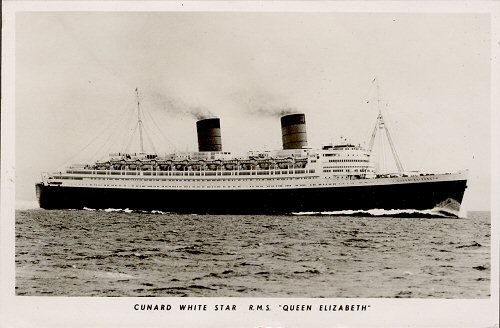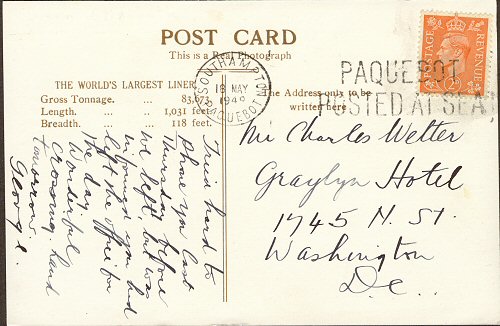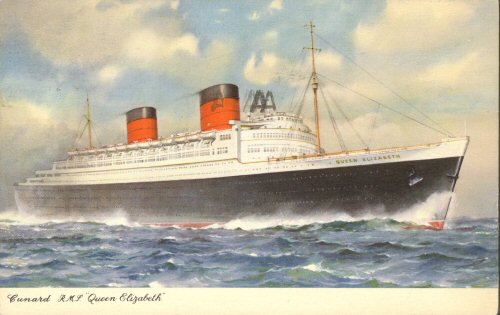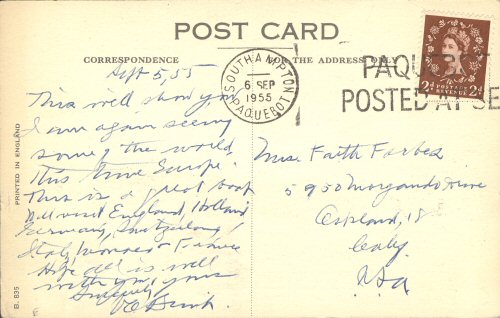
The Queen Elizabeth was the second of the two superliners which Cunard had built for the New York service. After lengthy negotiations between Sir Percy Bates, chairman of Cunard, and the Government a formal contract for what was known as job 535 was signed on 6 October 1936. The Treasury agreed to advance £5 million to Cunard and tenders went out for the contract. The contract went to John Brown & Co, builders of the Queen Mary.
Originally the launch of the ship was scheduled for September 1938 but as the time drew near the political situation across Europe had deteriorated. The launch did go ahead on 27 September but King George VI was unable to attend. After this the ship went to be fitted out and the completion date was set for spring 1940 but the outbreak of World War II, on 3 September, meant that the ship would follow a different agenda. Soon the ship was painted grey and its maiden voyage was cancelled. Over the next few months it was realised that the Queen Elizabeth was both a risk and an inconvenience whilst it was berthed on the Clyde. Not only was it at risk from German bombers but also it was occupying a fitting out berth which was urgently required for warship construction. On 3 March 1940 it left its anchorage off Gourock and sailed to New York, arriving on 7 March.
During March 1940 four of the world's greatest liners, the Mauretania, Normandie, Queen Elizabeth and Queen Mary, were berthed alongside each other. The Queen Elizabeth remained berthed at New York until 13 November and then set sail for Singapore, via Cape Town. The refit was completed in graving dock at Singapore and defensive armament was fitted. Internally it was fitted out to carry troops as it had now been requisitioned by the Ministry of War Transport. On 11 February it sailed from Singapore to Sydney, arriving on 21 February. After the fitting out was completed here it made a trooping voyage to the Middle East and spent the next five months carrying troops from Sydney to Suez, and returning with German POW's. After the US entered the war the Queen Elizabeth sailed to Esquimalt, in Canada, and carried troops to Sydney.
In 1942 the Admiralty drew up plans to convert the two Queens into aircraft carriers but these were later abandoned as it was considered that their troop carrying role was too important. In April 1942 the Queen Elizabeth relocated from Sydney to New York. Here the troop accommodation was altered to make its capacity 10,000. In June 1942 it began to make voyages from New York to Gourock and then to Suez, via Cape Town. In August it began a shuttle service between New York and Gourock. Despite the ever present threat of U-boats the ship continued its service unscathed, although the German press stated that a U-boat had hit the vessel with a torpedo on 11 November.
By the end of the war in Europe the Queens had brought over a million troops to the war zone. The ship's next duty was to repatriate these troops and redeploy troops for the war against Japan. The repatriation of American troops continued until October 1945 when the Queen Elizabeth was released from US service and allocated to the repatriation of Canadian troops. On 6 March 1946 it arrived back in Southampton and was released from Government service as the need for troop movements had diminished. During the war it had carried over 750,000 troops and travelled 500,000 miles.
The subsequent overhaul and refurbishment was to be carried out both on the Clyde and at Southampton. On 9 March 1946, before it left for the Clyde, a fire was discovered on the promenade deck. Luckily, as this was spotted early, the fire brigade was able to extinguish it but there was considerable damage to that area of the ship. Although it was never proved, arson was strongly suspected. At the end of March it left for the Clyde. There it was repainted in Cunard livery and its machinery was overhauled. By 17 June it was back at Southampton for interior refurbishment. It was soon announced that it would make its first passenger voyage to New York on 16 October 1946.
After speed trials and visit by the Queen, accompanied by Princesses Elizabeth and Margaret, it travelled to Southampton and set out on its maiden passenger voyage to New York on 16 October. Over the coming months the ship was fully booked and carried many famous passengers. On 17 April 1947 it ran aground on Brambles Bank whilst approaching Southampton in thick fog. Although no damage was done the passengers had to be disembarked and the bulk of the fuel pumped out before the ship could be refloated. Industrial disputes in 1948 left the Queen Elizabeth stranded at New York for two weeks. By September 1951 it had made its 100th Atlantic crossing. Despite being a huge success it had never broken any speed records, this was done by the Queen Mary and later by the United States.
During an overhaul in January 1952 the ship's fuel capacity was increased and air-conditioning fitted throughout. Again mysterious fires broke out in several passenger cabins but were easily extinguished. In January 1955 it was fitted with Denny Brown stabilisers. These improvements, however, were not enough to enable passenger liners to compete with air travel and by the late 1950's there were more people crossing the Atlantic by air than by sea. On 29 July 1959 the Queen Elizabeth was involved in a collision with the American Hunter, a United States Lines cargo ship. The collision occurred in the Ambrose Channel when both ships were outward bound from New York. During thick fog the American ship struck the starboard bows of the Queen Elizabeth but, luckily, damage to both vessels was only slight and temporary repairs were carried out at New York.
By 1962 the steady decline in the number of passengers led to an announcement that the ship would begin cruising the following year. Cruises from New York to Nassau began in February 1963. During one of these cruises a light aircraft smashed into the sea only a few hundred yards from the ship's stern. This occurred south-east of Cape Hatteras and as the pilot was killed all that could be done was to notify the coastguard. In March 1965 it was announced that the ship was to undergo a major overhaul. The work was done in Greenock and involved extensive redecoration and the installation of an open-air swimming pool. The work was completed in Spring 1966 but seamen's strikes immediately after this caused disruption for several weeks. On 8 May 1967 Cunard announced that the Queen Mary would be withdrawn from service later that year and that the Queen Elizabeth would be withdrawn in autumn 1968. The fact that the ship was still running at a loss after an extensive refit and that seamen's strikes had cost the company £14 million sealed its fate.
The Queen Elizabeth made its final Atlantic crossing on 5 November 1968. It had now already been sold to a group of Philadelphia businessmen for £3.25 million. After this it sailed to Port Evergaldes and opened to the public in February 1969. By the end of the year it had been closed down by the local authorities as a fire hazard and was losing money. By late 1970 the ship had been auctioned and bought by C.Y.Tung shipping group in Hong Kong and was intended to become a floating university. It was soon renamed Seawise University and sailed for for Hong Kong on 10 February 1971. Due to machinery problems it did not arrive until July and anchored off Tsing Yi Island near Kowloon.
Work soon began on a £5 million refit to convert the ship into a university and by January 1972 work was almost complete. Security on board, however, was lax and on 9 January several fires were discovered in various parts of the ship. The fires spread and the ship burned throughout the night. Soon the ship rolled on to its side and then the hulk continued to burn and smoulder for over a week. Fortunately there was only one casualty but it was clear that the ship was now only fit for scrap. An enquiry in July 1972 confirmed that it had been the work of an arsonist but the culprit was never found. In December 1973 it was decided to scrap the hulk. The ship's final protest came on 5 November 1975 when it rolled over and disgorged several tons of oil which polluted the surrounding waters and beaches.
Gross Tonnage - 83,673 tons
Dimensions - 300.94 x 36.14m (987.4 x 118.6ft)
Number of funnels - 2
Number of masts - 2
Construction - Steel
Propulsion - Quadruple screw
Engines - Single reduction steam turbines
Service speed - 29 knots
Builder - John Brown & Co Ltd, Glasgow
Launch date - 27 September 1938
Passenger accommodation - 823 1st class, 662 cabin class, 798 tourist class





